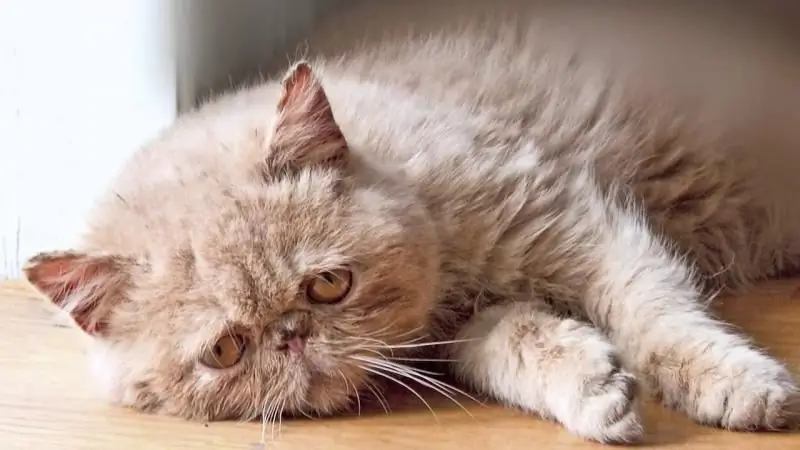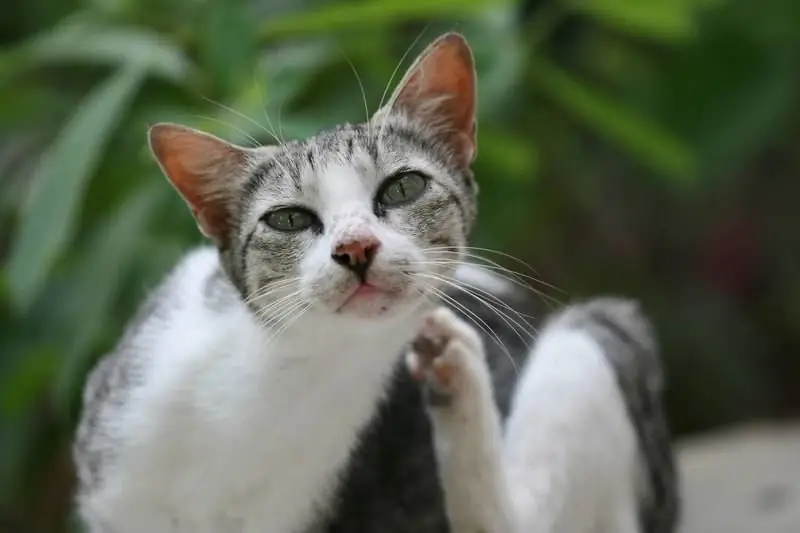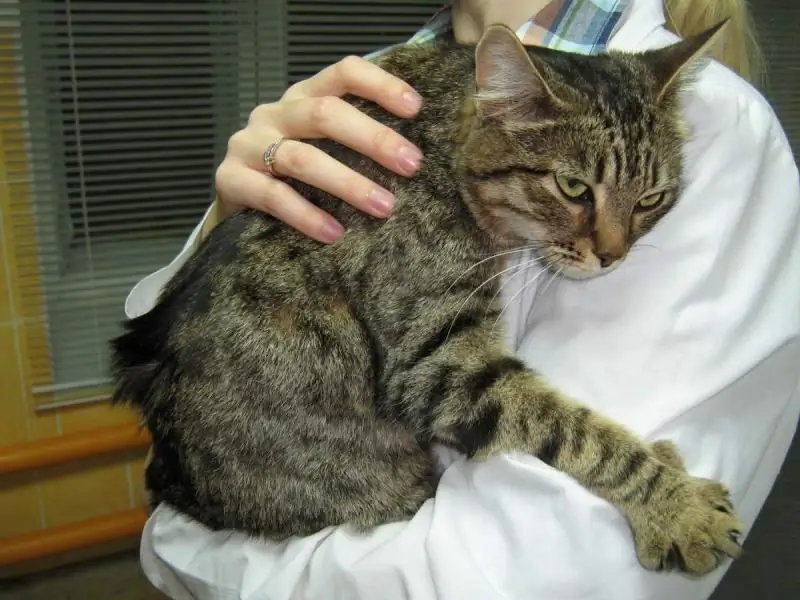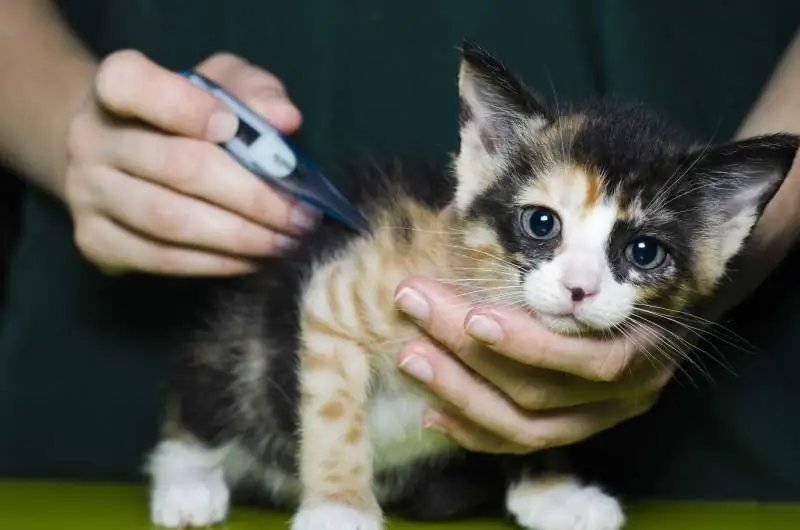
Table of contents:
- Feline viral leukemia: the best battle is the one that was avoided
- What is Feline Leukemia Virus
- Ways of infection of cats
- Feline viral leukemia
- Diagnosis of viral leukemia
- Viral leukemia treatment
- Helping your pet at home
- Survival prognosis and possible consequences
- Preventive measures
- Veterinarian recommendations
- Author Bailey Albertson [email protected].
- Public 2024-01-17 22:26.
- Last modified 2025-06-01 07:32.
Feline viral leukemia: the best battle is the one that was avoided

Feline viral leukemia is one of the lethal infections, since there are no drugs that effectively destroy the virus and are guaranteed to save the cat. If the cat's immune system does not overcome the virus at the first contact, then both the animal and the person will face an unequal battle for the pet and its quality. Nevertheless, there is a way to win this war without entering it.
Content
-
1 What is feline leukemia virus
- 1.1 Difference from immunodeficiency virus
- 1.2 Reasons for the development of the disease
-
2 Ways of infection of cats
- 2.1 Risk groups
- 2.2 Factors contributing to the spread of the disease
- 2.3 Video: Feline Leukemia
-
3 How feline viral leukemia manifests itself
- 3.1 Incubation period and disease onset
-
3.2 The main symptoms of leukemia
3.2.1 Photo Gallery: Symptoms of Feline Leukemia
- 3.3 When to see a veterinarian urgently
- 3.4 Video: Signs of Feline Leukemia
-
4 Diagnosis of viral leukemia
4.1 How to interpret the results
- 5 Treatment of viral leukemia
-
6 Helping your pet at home
- 6.1 First aid for a pet
- 6.2 Caring for an infected cat
-
6.3 Medicines used to improve the condition of the cat
- 6.3.1 Table: drugs for symptomatic therapy of viral leukemia
- 6.3.2 Photo gallery: medicines to improve the condition of an animal with viral leukemia
- 6.4 Features of the treatment of pregnant cats and kittens
- 7 Prognosis of survival and possible consequences
- 8 Preventive measures
- 9 Veterinarian recommendations
What is Feline Leukemia Virus
Feline leukemia virus is a retrovirus with widespread, but uneven distribution. The virus attacks the cat's immune system, disrupting its function and making it susceptible to the development of secondary as well as opportunistic infections (those that healthy immunity usually suppresses itself). In addition, the virus has an oncogenic effect, causing uncontrolled proliferation of cells affected by it with the development of lymphomas and leukemia.
It is the defeat of the immune system that provides a wide variety of clinical manifestations in viral leukemia. The signs of the disease are especially pronounced in the organs and systems that carry out the barrier function - the digestive and respiratory systems, as well as the skin.
Feline leukemia virus is unstable in the external environment and is easily destroyed by disinfectants, treatment with soapy solutions, as well as drying or heating.
Difference from the immunodeficiency virus
Feline leukemia virus is often confused with immunodeficiency virus because both are retroviruses and affect the immune system, while showing similar symptoms. But there are differences between these pathogens:
- Feline immunodeficiency virus infects only mature cells of the immune system circulating in the blood, while feline leukemia virus infects the hematopoietic organ - bone marrow, causing the production of abnormal cells of the immune system, which are unable to perform protective functions and are themselves involved in the course of the disease, forming tumors … Thus, immune disorders in viral leukemia are much more complex and severe than in viral immunodeficiency.
- In viral leukemia of cats, lymphomas often develop due to the activity of cells of the immune system altered by the virus, while in viral immunodeficiency there is a decrease or loss of the functions of immunocompetent cells. Malignant neoplasms are not typical for him.
- Feline immunodeficiency virus has a wide variety of subspecies, which makes it difficult to create a vaccine. Nevertheless, a vaccine has been created, but it is used only in the United States. Vaccine prophylaxis has been developed and is widely available to protect against viral leukemia.
- In veterinary medicine, there are cases of complete recovery from viral leukemia. No such data have been reported about a viral immunodeficiency disease.
In some cases, the similarity of the symptoms of these two diseases is so pronounced that it is possible to accurately determine the pathogen only with the use of laboratory diagnostic methods.

Feline Leukemia Virus Infects Rapidly Dividing Cells
The reasons for the development of the disease
The source of infection is cats with viremia - a condition when the virus circulates in their blood and is actively excreted through saliva, excrement, phlegm, and also through milk during lactation.
Viral leukemia, in addition to domestic cats, affects large wild cats. This pathogen is not dangerous for people, dogs, and other domestic animals.
Ways of infection of cats
The causative agent of viral leukemia is characterized by many ways of infection:
- contact - with bites, as well as with mutual licking;
- oral - when using shared bowls;
- aerogenic - by inhaling small droplets of infected saliva or sputum;
- sexual;
- intrauterine infection;
- iatrogenic - by transfusing infected blood or using untreated instruments.

Infection can take place with close social interaction
At-risk groups
Risk groups include animals with certain characteristics:
-
age:
- most often the disease is diagnosed at the age of 3;
- the age interval from 1 to 6 years is considered dangerous;
- kittens are highly vulnerable;
- free access of a cat to the street, as well as a wide and uncontrolled circle of her communication;
-
high density of the cat population - the virus is unstable outside the body, and its transmission facilitates close cohabitation and social interaction of cats, especially when one of them or several have access to the street;

Many cats Street cats living in groups are at risk of contracting viral leukemia
- poor hygiene - facilitates infection with an environmentally unstable virus, for example, when using shared bowls or grooming tools;
- male sex - the ratio of infected cats to cats is 1: 1.7, as cats, especially non-castrated cats, tend to get involved in fights.
Factors contributing to the spread of the disease
As factors contributing to the spread of the disease, there are:
- a large number of stray animals that are reservoirs and carriers of infection;
- neglect of vaccination;
- lack of examination and quarantine when introducing new animals into a closed cat population (nursery, shelter);
- inaccessibility of laboratory diagnostics in certain settlements;
- the absence of special educational programs for veterinarians, which are necessary, since this disease does not have characteristic external manifestations that allow reaching a correct diagnosis without using laboratory diagnostic methods.
Video: feline leukemia
Feline viral leukemia
Clinical signs of viral leukemia in cats vary widely from their complete absence in case of asymptomatic carriage, to the most severe forms of the disease with multiple organ damage, a widespread neoplastic process and the active participation of secondary infection.
Incubation period and disease onset
After infection, the virus develops as follows:
- Reproduction of the virus in the tonsils, retropharyngeal lymph nodes.
- Penetration into macrophages and blood B-lymphocytes, thereby creating conditions for the spread of a viral infection.
- Settling and the beginning of reproduction in the lymphoid tissue of the thymus gland, in the crypts of the epithelium and Peyer's patches of the intestine, as well as in the red bone marrow with infection of progenitor cells.
- The release of infected neutrophils and platelets from the bone marrow into the bloodstream.
- The penetration of the virus into the cells of the epithelium and glands, where it multiplies and is excreted in large quantities with biological fluids and excrement.
At stages 2 and 3, during the development of the disease, suppression of protective immune responses occurs, which corresponds to a period of 1-2 months after infection; stages 4 and 5 are characterized by the development of persistent (permanent) viremia - this is a state of constant presence of viral particles in the blood, for its development it takes 1-3 months after infection.
With an adequate immune response, viremia is suppressed and the disease does not develop further. A cat that overcomes viremia becomes latently (latently) infected, and reactivation of the infection is possible in case of an immunodeficiency state. The active immunity of the cat does not allow the virus to multiply, and the latter is determined only in the form of viral DNA integrated into the DNA of the host cell, the so-called provirus. This means that, while maintaining favorable living conditions, this cat is able to live to a ripe old age.
If we turn to the statistical results obtained during the examination of infected cats at shelters in the 80s of the last century, and use them as a prognosis for the development of the disease, it turns out that:
- 30-40% of animals will develop persistent (permanent) viremia and clinical manifestations of infectious leukemia;
- in 30-40% of cats, viremia will be intermittent, intermittent; this condition reflects the partial ability of the cat's immunity to restrain the aggression of the virus, while the virus may gradually colonize the bone marrow and lymphatic tissue, and the symptoms of the disease may appear after several years, and it is also possible to pass into latent infection if the cat's immune system wins;
- 20-30% of cats do not have viremia, but there are antibodies - this is a latent infection when the immune system keeps the virus under control;
- in 5% of cats, the course is atypical, when virus antigens are detected in the blood in the absence of viremia.
Therefore, the incubation period for this disease can last from several weeks to several years, and asymptomatic carriage is also possible.

Good grooming is important for a strong cat's immunity.
The main symptoms of leukemia
The most common clinical manifestations of feline viral leukemia are:
-
immunosuppression (suppression of the function of the immune system) and a predisposition to the development of various infections, manifested by:
-
chronic inflammatory processes characteristic of weakening the barrier functions of the immune system, the treatment of which is difficult due to the immunodeficiency state:
- sinusitis - inflammation of the mucous membranes of the paranasal sinuses;
- rhinitis - inflammation of the nasal mucosa;
- gingivitis - inflammation of the gums;
- periodontitis;
- the appearance of abscesses (abscesses) on the skin;
-
the development of bacterial, fungal and viral infections of the respiratory system and intestines, which are accompanied by persistent fever and increasing exhaustion:
- there is a predisposition to infection with viral peritonitis of cats, as well as hemobartonellosis;
- infections that cats are usually resistant to may develop, such as salmonellosis;
- the appearance of panleukopenia syndrome, typical of the disease of the same name, it occurs in cats vaccinated against the causative agent of panleukopenia, and is absolutely fatal;
-
- anemia - apparently, the virus disrupts the synthesis of hemoglobin, and also inhibits the bone marrow, anemia greatly worsens the condition of cats, weakness and shortness of breath increase, with a strong decrease in the number of erythrocytes, the cat stops eating;
-
lymphoma - develops in about 20% of cases in cats with persistent viremia, all forms of lymphoma are characterized by lethargy, anorexia and wasting:
- alimentary form - manifested by lack of appetite, diarrhea, vomiting, tumor masses capture the small and large intestines, as well as the lymph nodes of the abdominal cavity;
- multicentric form - lymphosarcoma affects the liver, kidneys, spleen and lymph nodes; this form of flow is typical for young cats;
- thymic - the thymus gland is affected, while there are violations of swallowing, breathing, with large tumor sizes, there may be cyanosis, as well as effusion in the pleural cavity;
- lymphoid leukemic form - primary damage to the bone marrow occurs, which is accompanied by the release of a large number of malignant lymphocytes into the blood, the liver, spleen, lymph nodes are secondarily involved, manifested by fever, anemia, jaundice;
- myeloid leukemia - is also characterized by primary damage to the bone marrow, myeloid cells, with rapidly progressing anemia and weight loss, fever attacks and secondary involvement of the liver, spleen and lymph nodes.
Less common:
-
autoimmune manifestations:
- polyarthritis;
- hemolytic anemia;
- glomerulonephritis;
- chronic enteritis, accompanied by necrosis of the crypts of the mucous membrane;
-
diseases of the reproductive system, manifested in:
- resorption of fruits;
- abortion;
- neonatal death and reduced viability of the litter;
- infertility;
-
damage to peripheral nerves with the formation of neuropathy, which is manifested by:
- paresis;
- paralysis;
- changing the timbre of the voice;
-
violation of the innervation of the eyes:
- different sizes of pupils;
- dilated pupils;
- other eye symptoms.
Photo gallery: feline leukemia symptoms
-

A thin cat lies - A cat with leukemia is exhausted
-

White skinny cat sitting on the table - In leukemia, a secondary infection, such as an eye infection, is often added to wasting.
-

Enlarged reddened eye in a cat - Terminal glaucoma is one of the ocular manifestations of leukemia
When you need to urgently see a veterinarian
Despite the absence of clinical symptoms specific to this disease, there are signs that are constantly encountered with this disease:
- periodic fever;
- lethargy, lack of desire to play;
- skin diseases, as well as diseases of the digestive and respiratory systems, recurring or persistent;
- drooling as a result of a virus in the salivary glands;
- anemia - pallor of the mucous membranes, weakness, shortness of breath;
- weight loss.
There may be other signs that are not always met, but often:
- discoloration of urine - blushes;
- fainting;
- convulsive syndrome;
- impaired coordination of movements;
- poor blood clotting, bleeding.
Video: signs of feline leukemia
Diagnosis of viral leukemia
All cats should be tested for possible carriage of the leukemia virus, especially:
- in animals at risk;
- in the presence of signs of disease, since viral leukemia is characterized by a variety of symptoms;
- in cats taken from the street or from a shelter, especially when there are already cats in the house;
- before prophylactic vaccination against viral leukemia.
Diagnostic methods:
- ELISA (enzyme-linked immunosorbent assay) - determines the viral antigen in case of damage to platelets, leukocytes, lymphocytes, diagnostic sensitivity is 90%;
- PCR (polymerase chain reaction) - determines the DNA of the provirus (when the viral DNA is embedded in the genome of the host cell), the most reliable diagnostic method;
- PCR diagnostics aimed at detecting the RNA of the virus is reliable evidence of viremia, which can even be used to study pooled samples in order to save money, for example, when examining nurseries;
- immune chromatography - also determines the viral antigen in blood cells, diagnostic sensitivity is 90%;
- RIF (immunofluorescence reaction) - detects viral components in blood smears, diagnostic sensitivity is much lower than that of PCR diagnostics, a positive result usually indicates persistent viremia;
- the cultivation of the virus is the most sensitive method, especially in the early stages of the disease, now it is used extremely rarely in routine practice.
How to interpret the results
A few days after infection, PCR diagnostics tests for provirus DNA and virus RNA become positive, and later for ELISA. If the cat has a stable presence of the virus in the blood, it will give positive results on all tests.
The most widely used are immunochromatographic rapid tests. Their positive results in a clinically healthy cat should always be confirmed, preferably using PCR. If the cat shows signs of an infectious disease, the results are considered more reliable as more widespread virus spread is expected to ensure the accuracy of the test method.
A cat's immunity is able to overcome viremia within 2-16 weeks, so all cats with no signs of illness, but with positive test results, should be quarantined and re-examined after a few weeks. A cat, whose body has overcome viremia, will give negative results in ELISA, RIF, immunochromatographic analysis, PCR diagnostics for RNA of the virus, but the results of PCR for detecting provirus DNA will be positive. This is a state of latent infection.
In 2-3% of cases in cats, foci of infection outside the bone marrow are formed, they will give positive results in ELISA tests and immunochromatography. These cats are a potential source of infection.
A healthy cat is considered to be one whose result is repeated negative after 12 weeks.

Most often, viral leukemia infection occurs in a fight.
Viral leukemia treatment
There is no etiotropic therapy against the causative agent of the disease. With the help of symptomatic and supportive therapy, you can mitigate the course of the disease and increase life expectancy. Animals with viremia need medical help, they are shown:
- supportive therapy, including intravenous infusion - if indicated;
- good care;
- avoidance of corticosteroids, which suppress the function of the red bone marrow and immunity, in special cases they can be used very carefully under the supervision of a veterinarian;
-
early detection and treatment of secondary infections using antibacterial drugs:
- amoxicillin;
- fluoroquinolones;
- cephalosporins;
- doxycycline;
- immunomodulators - SPA-bacterial peptide of Staphylococcus aureus, allows you to restore the function of the immune system weakened by the virus and helps control viral load; applied for 10 weeks 10 mcg / kg twice a week; the immune status does not change, but the owners subjectively note an improvement in the cat's health;
-
antiviral drugs:
- Virbagen Omega is a French drug, not registered in the Russian Federation, usually imported from abroad;
- Azidothymidine - there is a high likelihood of side effects, 5-10 mg / kg is used subcutaneously or orally every 12 hours under the supervision of a physician;
- acemannan - a mucopolysaccharide from the leaves of Aloe vera, which has antiviral, antitumor effects, is currently available in China, quality control is questionable;
- recombinant alpha interferon;
- blood transfusions - can increase life expectancy, in case of severe anemia, they are carried out once every 2-3 weeks;
- cytostatic therapy for lymphomas: vincristine, cyclophosphamide in courses of 3-4 months; remission is achieved for several months, the prognosis for lymphomas is poor;
- surgical care according to indications;
-
special diet for:
- kidney damage;
- cachexia;
- diarrhea.
Inpatient treatment may be needed by cats with:
- severe course of secondary infection;
- severe anemia;
- severe exhaustion (cachexia);
- in need of surgical care.
Helping your pet at home
At home, the appointment of a veterinarian is carried out, and caring for an infected or sick cat is very important.
First aid for a pet
First aid to the pet consists in delivery to the veterinarian and carrying out a comprehensive examination, since both the viral leukemia itself and those diseases that develop against its background need quick and accurate diagnosis. It is desirable that the clinic has accumulated experience in the management of such patients.

If you suspect leukemia, the cat must be urgently taken to the clinic
Caring for an infected cat
If the cat is infected but clinically healthy, then:
-
twice a year, for the purpose of prophylaxis, show the cat to the veterinarian, on examinations it is necessary to carry out:
- control weighing of a cat with subsequent comparison of the results in dynamics, since weight loss may indicate the onset of the disease;
- a complete examination of the animal, with special attention to the lymph nodes, eyes and mouth;
-
1-2 times a year to carry out:
- general and biochemical blood test;
- general urine analysis;
- stool analysis;
- vaccinate the cat with only inactivated vaccines using the usual schedule;
- sterilize an infected cat, do not use for breeding;
- keep the cat indoors only;
- in a veterinary clinic - to be kept in a separate cage away from other animals, especially those with respiratory infections;
- do not feed raw meat to avoid bacterial infections and parasitic infestations.
If the cat has developed signs of illness, then some of the treatment measures, for example, taking pills, intramuscular injections, washing the eyes, applying ointments, are carried out at home.
Medicines used to improve the condition of the cat
For symptomatic treatment of viral leukemia in cats, drugs from different therapeutic groups are used.
Table: drugs for the symptomatic therapy of viral leukemia
| A drug | Structure | Operating principle | approximate cost |
| Sinulox |
|
Broad-spectrum antibacterial drug | 235 rubles for 10 tablets of 50 mg |
| Tsiprovet | Ciprofloxacin | Broad-spectrum antibacterial drug | 125 rubles for 10 tablets of 15 mg |
| Doxycycline hydrochloride | Doxycycline | A broad spectrum antibacterial drug with antiprotozoal activity; used to treat hemobartonellosis | from 18 rubles |
| Metrogyl Denta | Metronidazole | Antibacterial drug for local treatment of stomatitis, gingivitis | from 195 rubles |
|
Human recombinant alpha-2b interferon | Antiviral, anti-tumor effects; stimulates cellular immunity | 1248 rubles 3 mln IU 1 ml No. 5 |
|
Azidothymidine |
|
2800 rubles for 200 mg / 20 ml No. 5 |
| Vincristine | Vincristine | Cytostatic, inhibits tumor growth | 209 rubles for 1 mg No. 1 |
|
Cyclophosphamide | Cytostatic, inhibits tumor growth | 700 rubles for 50 tablets of 50 mg |
| Virbagen Omega | Feline Omega Interferon |
|
525 € for order from Germany (it will be cheaper to order for leaving friends) |
Photo gallery: medicines to improve the condition of an animal with viral leukemia
-

Sinulox suspension - Sinulox for cats is an effective bactericidal agent, an antibiotic of the penicillin group
-

Tsiprovet - Ciprovet is an antibacterial drug that is used to treat various infections in cats
-

Doxycycline - Doxycycline is a semi-synthetic antibiotic of the tetracyclines group of broad spectrum of action
-

Metrogyl Denta - Metrogyl Denta is an OTC drug in the form of a gel, an antibiotic used for infectious and inflammatory diseases of the oral cavity
-

Vincristine - Vincristine is a cytostatic agent (suppressing tumor growth)
-

Cyclophosphamide - Cyclophosphamide is an antineoplastic drug
Features of the treatment of pregnant cats and kittens
The course of pregnancy in a sick cat is hopeless, since fetuses are resorbed, abortions, kittens born die in the first few days of life, the cat develops infertility. Infected and sick animals are sterilized, they are no longer suitable for breeding. Treatment of a sick pregnant cat is exclusively in the interests of the cat, carrying out the entire complex of symptomatic and supportive therapy in accordance with its condition.
Survival prognosis and possible consequences
The prognosis for cats with persistent (persistent) viremia is unfavorable: up to 70-90% die within 18 months to 3 years. Latently infected cats that do not have the virus in their blood live to a very old age or have other causes of death.
Preventive measures
Preventive measures include:
-
Vaccination of cats. Only cats without hidden carrier can be vaccinated. Kittens are vaccinated from 12 weeks after preliminary testing for the leukemia virus. After 2-3 weeks, they are revaccinated with the subsequent annual introduction of the vaccine. The effectiveness of this vaccine is significantly lower, for example, than that of the rabies vaccine, therefore it is recommended to supplement it with the exception of contacts with stray animals. Kittens born from vaccinated cats have colostral immunity up to 6-12 weeks. The procedure itself is not mandatory, but it is better to carry it out, since the expected benefits outweigh any risks. The drugs are used:
- Merial;
- Solvay;
- Fort Dodge;
- Pitman Moore.
- Timely identification and isolation of sick animals and carriers.
-
Taking good care of your cats:
- disinfection of dishes and care items;
- wet cleaning of the premises with soap solutions;
- lack of crowding.
- Exclusion of contact with stray animals, especially if the epidemiological situation for viral leukemia is unfavorable.
Veterinarian recommendations
Thus, vaccination is of paramount importance in protecting a cat from the leukemia virus. It is also important to take good care of the cat, maintaining a high functional state of its immune system, which can limit viral aggression. An additional measure is limiting contact with stray animals.
Recommended:
Ear Mite (otodectosis) In Cats And Cats: Photos, Symptoms Of The Disease And Its Treatment At Home (including A Kitten), Reviews

Description of the causative agent of otodectosis, how the infection occurs, the symptoms of the disease. How to diagnose and treat otodectosis. Preventive measures
Immunodeficiency In Cats: Which Virus Causes The Disease, Main Symptoms, Treatment And Prognosis Of Survival, Recommendations Of Veterinarians

The causative agent of viral immunodeficiency in cats. Infection routes. How it manifests itself. Diagnostics. Treatment and care. Review of drugs. Forecast, prevention
Renal Failure In Cats And Cats: Symptoms, Treatment, How To Save A Kitten And An Adult Animal (recommendations Of Veterinarians)

Types of renal failure in cats The reasons for its development. How pathology manifests itself and is diagnosed. Inpatient and home treatment. Prevention
Epilepsy In Cats: Symptoms Of The Disease, How To Stop Seizures, Can Seizures Be Prevented, Treatment Methods, Veterinarian Recommendations

What is epilepsy. Causes of the disease, forms and manifestations. Features of diagnostics. Treatment methods: medication, diet. Care rules. Prevention
Eosinophilic Granuloma In Cats: Symptoms And Treatment At Home, Prevention And Recommendations Of Veterinarians

How does eosinophilic granuloma of cats look and proceed? Causes, diagnosis, prevention and treatment methods. Veterinarian recommendations
